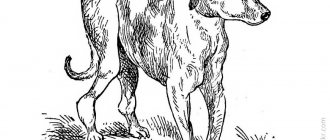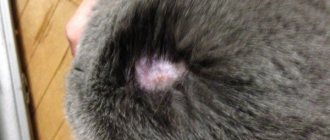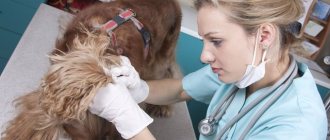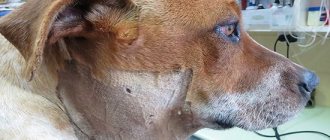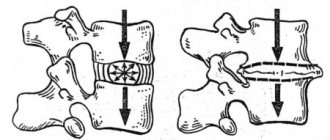A single sneeze from a pet not only does not frighten, but also touches. Because of this, videos of sneezing animals get quite a lot of views and likes.
But a completely different picture is typical for reverse, or reverse, sneezing in dogs. This syndrome can plunge unprepared owners into real horror, since its symptoms are very similar to a number of dangerous diseases.
What does it look like
It's quite easy to identify him. After all, every person has seen a sneezing dog. Here the picture is exactly the same, but the sneezing itself does not look like a sharp exhalation, but like an inhalation. Moreover, most often a whole series of similar sneezes occurs. Usually such convulsive breaths are accompanied by grunting or snorting. In some cases, dogs stretch their necks, lie on their stomachs, fall on their front paws, or tense their pectoral muscles. Some breeds may experience an increased amount of saliva produced.
The duration of attacks is rarely long - they are almost always limited to one minute or even less. Once completed, the dog behaves normally, showing no symptoms of pain or discomfort.
But outwardly it looks quite scary - an inexperienced owner may immediately think that the dog is having some kind of dangerous attack or is suffocating. However, there is usually no reason for concern and an immediate visit to the veterinarian; as long as you dial the phone or look for the car keys, the symptoms of reverse sneezing in your dog will pass.
What breeds does it occur in?
In general, reverse sneezing can be seen in dogs of almost all breeds. But first of all, small dogs are susceptible to this: French bulldogs, pugs, Pekingese, poodles, Yorkies, toy terriers. This is due to the structural features of the skull - note that all the breeds listed above have a short muzzle. Most often it is the elongated soft palate. When you inhale sharply before a normal sneeze, it can be sucked into your windpipe, causing reverse sneezing.
Of course, it sounds quite creepy, and it doesn’t look too fun. But it’s worth repeating, in most cases there is no reason to worry too much and visit a veterinarian.
Causes of reverse sneezing
Unfortunately, doctors have not yet established the exact causes of reverse sneezing in dogs. There are quite a few hypotheses why such a phenomenon can be observed, but it has not been clearly proven which one serves as the trigger for a series of reverse sneezes. However, it is possible that there are several reasons for this. Therefore, it will be useful to talk about each of them.
One version is nervous overstrain or overexcitation. Indeed, quite often reverse sneezing begins precisely at the moment when the dog is extremely happy, for example, the owner has come home from work. Or, on the contrary, when she is frightened by something, for example, the owners decided to clean up the house and turned on the vacuum cleaner - the worst enemy of many dogs.
Another possible reason is strong odors. If a dog who has lived in your family for many years has symptoms of reverse sneezing for the first time, try to remember if you have recently changed your perfume or shampoo, liquid soap, or detergent in the kitchen. Don’t forget that pleasant and barely noticeable odors can hit your dog’s smell receptors powerfully. After all, their sense of smell is a much more important tool in understanding the world around them. This can also be observed after repairs, for example, painting floors or varnishing furniture. In general, nothing bad will happen - over time the smell will disappear or the dog will get used to it.
It is much worse when reverse sneezing in small breed dogs occurs as a result of small foreign bodies entering the respiratory tract. Curious dogs try to sniff any small objects. It is quite natural that with powerful snoring (pugs and bulldogs are especially notable for this) they could inhale something. In this case, veterinary assistance may be required.
Finally, the cause may be excessive stress, heat or a low amount of oxygen in the room. Don't forget, dogs with short muzzles often suffer from heat. After all, they “sweat” only with their tongue, thus cooling the body. A short muzzle sharply reduces the efficiency of the process.
Kegel exercises for pregnant and postpartum women
Pregnancy and childbirth are a difficult process for the body, during which the condition of the muscles in the pelvis plays a big role. Weak tone of other muscles of the body, although it can cause discomfort, is not so dangerous. Weakened pelvic muscles are fraught with painful, protracted labor, as well as decreased libido, prolapse and prolapse of the uterus, and urinary incontinence. Often women experience urine leakage, both during pregnancy (the fetus puts pressure on the bladder) and after childbirth. The second option awaits those who have poor muscle function. Therefore, doctors recommend training them in advance, monitoring their condition during pregnancy and maintaining muscle tone after childbirth.
While carrying a child, thanks to Kegel exercises for urinary incontinence, a woman's tissue elasticity increases, venous congestion decreases, joint mobility improves, intestinal function improves, and the risk of involuntary urine loss decreases. Kegel exercises to strengthen muscles are also important for the process of childbirth itself, since their condition directly affects the maintenance of pregnancy and recovery in the postpartum period.
It is convenient that the training can be carried out at home - Kegel exercises for women do not require a special room and exercise machine and can be performed at any time. You need to exercise before and after childbirth, since muscle elasticity is always needed. Before the baby is born, this will help him to be born, and after that it will speed up the healing of ruptures and prevent organ prolapse. Even after a cesarean section, exercise is beneficial because muscle tone in pregnant women is reduced due to gravity.
How harmful is it?
As mentioned above, reverse sneezing in itself does not pose any danger. However, it is worth considering that in some cases it is only a symptom indicating the presence of more serious diseases.
For example, in pugs, French bulldogs and Pekingese, bracheocephalic sign syndromes are very similar to reverse sneezing - an inexperienced breeder may well confuse them.
Therefore, if you notice at least once reverse sneezing in your pet, you should remember it. If it repeats extremely rarely, several times a month, and the dog feels great, then there is no need to panic - everything will either pass with time or remain at the same level, which does not bother the dog too much.
It is much worse if all the symptoms begin to appear in an adult dog, and over time their frequency will increase. The breeder should also be concerned about copious nasal discharge that accompanies sneezing.
Well, if you notice that during one of these attacks your pet has lost consciousness, then you cannot hesitate - you need to immediately contact a specialist. There is a high chance that heart failure or serious allergic reactions are occurring. In this case, if the real causes of reverse sneezing syndrome in dogs are identified earlier, treatment will be more effective and easier.
The right approach
Experts give the following recommendations on how to properly perform Kegel exercises for women:
- empty your bladder immediately before class;
- choose a comfortable position - sitting, lying or standing. If the preferred position is lying on your back, your arms should be extended along the body and your knees slightly raised. The neck should not be strained;
- The main movement in any Kegel exercise for women is compression (contraction). It is important to avoid tension in the abdominal muscles, buttocks and thighs, otherwise there will be no result;
- you need to breathe deeply, evenly and calmly, without delay;
- you cannot contract the intimate muscles when urinating - this method, on the contrary, weakens the pelvic floor muscles;
- repeat the complex 3-4 times during the day, performing 5 to 40 repetitions each time. You cannot sharply increase the load, only gradually: perform 15 repetitions for 2 weeks, 20 repetitions for the next 2 weeks, etc.
The correct technique for performing Kegel gymnastics for women allows you to feel the first positive results after just six weeks of regular exercise. Changes will be noticeable in all areas of life, including intimate ones, and self-confidence will even increase.
If you do see a doctor
Is your dog experiencing any of the warning signs listed above? In this case, it is still worth contacting a veterinarian. It’s better for him to examine the patient, take payment and reassure you that the dog is healthy and in great shape, than for a dangerous disease to be neglected, time wasted and this will cause a serious illness or even the death of the dog.
By the way, when turning to specialists, it will be useful not only to talk about the symptoms, but also to demonstrate them. Of course, a dog will not sneeze when ordered. But most owners today have smartphones with very good cameras. By recording a sneezing attack on video, you can make the veterinarian’s job much easier. An experienced specialist, having looked at such a recording, will say with a high degree of confidence whether this is ordinary reverse sneezing or whether there are other symptoms that pose a great danger to the pet’s life.
Diagnostics
When you contact a veterinarian, be prepared for him to prescribe certain procedures that will allow you to more accurately diagnose the disease.
To begin with, an experienced specialist will check for the presence of foreign objects in the respiratory tract. Yes, any little thing that gets into the nose or gets stuck in the nasopharynx can provoke attacks of reverse sneezing, sometimes leading to suffocation.
Tests will certainly be carried out to confirm or reject the possibility of developing laryngitis or rhinitis of various types. Unfortunately, sometimes they give about the same effect or simply cause reverse sneezing.
There are certain infectious diseases that lead to the same consequences. Fortunately, a routine blood test in most cases can accurately identify them and, accordingly, prescribe effective treatment that quickly leads to the desired results. Among such diseases are: herpes, chlamydia, adenovirus, bordetellosis, parainfluenza and others.
In some cases, dental problems can lead to exactly the same consequences. Having solved the problem, you will immediately relieve your pet from attacks - long-term treatment of reverse sneezing in dogs will not be required.
A veterinarian may also diagnose a common elongated soft palate. In this case, there is no need to worry - alas, you will not be able to get rid of attacks of reverse sneezing, but it will not develop into more serious problems.
Brachycephalic obstructive syndrome. Interview with a surgeon
With this interview, we open a series of publications based on materials from lectures given by Biocontrol doctors at meetings of the BioClub, the school of responsible ownership.
We talked about brachycephalic obstructive syndrome, the causes of its occurrence, stages of development and treatment with the leading surgeon, endosurgeon of Biocontrol, Lev Valerievich Golub.
- So, brachycephalic syndrome. What is this?
— Brachycephalic obstructive syndrome. It is obstructive, from the Latin obstructio - hindrance, obstacle, because this word adds and explains the severity of this condition. Brachy - short, cephalo - relating to the head. Together, this indicates a shortened skull, or more precisely, a shortened facial part of the skull.
This syndrome means that the animal has an obstruction to the air it can breathe.
— What breeds are brachycephalic and are predisposed to this syndrome?
— French and English bulldogs probably take first place. Next come pugs and other breeds: griffins, shih tzus, pekingese, boston terriers.
Labradors are mesocephalic, that is, their facial part of the skull is not short, but medium. But they also have problems, although they are less pronounced than in French or English bulldogs.
This syndrome occurs in Spitz dogs, Yorkies, Chihuahuas, as well as boxers, bullmastiffs and, oddly enough, Dogues de Bordeaux.
— How does brachycephalic obstructive syndrome arise and develop?
— Its development can be compared to a snowball. It starts simple - the dog has shortness of breath, wheezes and snores, and then it becomes more and more complex.
The very first thing we can see, where brachycephalic obstructive syndrome begins, is the narrowing of the nostrils. Narrow nostrils are one of the first factors that can further lead to the development of all other pathologies associated with this syndrome.
Problems are growing gradually. At the first stage, we see aberrant turbinates (aberrant - deviating from the normal state) with obstruction. These are shells that humans and animals have, and when they become aberrant, this means that they fall out into the choanae (internal nasal openings) and partially block the lumen.
At the second stage, we note dynamic nasopharyngeal collapse. This is where the laws of physics come into force, namely the Venturi effect. Bottlenecks cause accelerated air flow, which reduces pressure. Due to this, the walls collapse.
The third stage of development of the syndrome is hyperplasia of the soft palate, in length and thickness. Many people think that the soft palate elongates and is therefore a problem. In fact, this is not always the case. That is, the palate, in addition to lengthening, also thickens. And sometimes it does not lengthen, but simply thickens and the nasopharyngeal passage narrows.
The next stage of development is eversion of the laryngeal sacs.
Then the collapse of the larynx develops - the laws of aerodynamics work again. The difference in air flow leads to collapse.
The sixth stage is laryngeal hyperplasia and thickening, prolapse of the longitudinal dorsal membrane. The trachea has a hard part, which consists of cartilaginous rings, and a longitudinal membrane that connects them. It thickens and prolapses (sags) into the lumen. Due to this, collapse also occurs.
What else often happens: gastroesophageal reflux disease. If a pressure difference occurs in the chest and abdominal cavities, when the dog tries to breathe, due to this, part of the stomach can be pulled into the lower esophagus, and, accordingly, gastric juice and acid are thrown into the esophagus. We often observe this in brachycephalics: they breathe, cough, belch, they can regurgitate, and against this background we can assume gastrointestinal disorders. Yes, these could be stomach disorders, but first of all, in a young dog with such signs, it is necessary to exclude brachycephalic syndrome.
Well, the last stage is bronchial collapse.
— How and when is the diagnosis of “brachycephalic obstructive syndrome” made?
- In approximately eighty percent of cases, the diagnosis becomes clear based on the breed and medical history. If we see a panting French bulldog, six or seven years old, at a reception, we can definitely assume that this is BCS. Because the manifestation of all signs begins just at the age of six or seven years.
- Not earlier?
- I'm talking about a clear manifestation of symptoms. Of course, the disease itself begins much earlier. This is precisely the factor when it is difficult to convince the owner of what needs to be done to the dog already in childhood. Because the owners think: well, that’s how all French bulldogs breathe. It seems like it’s even funny that the dog is snoring. But in fact, these are already prerequisites that the condition may worsen in the future.
— So, normally no young dog should snore?
- No.
- So, even the mere fact of snoring is not a reason for emotion, but a reason for a visit to a veterinary surgeon?
- Yes, this is a reason to consult a specialist.
— How is such a patient examined?
— What is syndrome? This is a complex of symptoms. And here the symptoms come from different parts and different organs. Actually, this is how we looked at this snowball, starting from the nostrils and further to the nasal cavity, nasopharynx, larynx, bronchi, and reflux disease.
That is, all this needs to be examined in order to present a complete picture of what is currently happening with the dog, and where we can correct the condition. And if we don’t do this, we will definitely miss something and the result of our correction will, let’s say, not be entirely effective. If we do not further examine the patient, we may get relapses or some other problems.
— Where does the examination begin?
- From taking an anamnesis. The main symptom is starter . In science it is called this, but in the people it is called snoring. Not to be confused with strider - this is the name of the whistling sound caused by paralysis of the larynx.
Second symptom. Dyspnea is a breathing disorder. Appears even under light loads. He barked, ran a little and that’s it, he can no longer breathe normally, but stands with his limbs spread to the sides and breathes heavily.
What else? Exercise intolerance, overheating at elevated temperatures, and syncope are when an animal becomes so hypoxic or overheated that it faints and then wakes up. A kind of protective mechanism in the body.
Why do they overheat? Because the dog provides itself with cooling in the body mainly through the mouth. And if air exchange is disrupted, then of course the temperature begins to rise.
— What pathologies can accompany and provoke symptoms of BCS?
- Obesity. The first factor in the world among brachycephalics, which complicates the course of this entire pathology. Clinical symptoms of BCS can occur in animals at an early age if there are signs of obesity. Because short necks, small skulls, all this compresses the soft tissues of the neck and leads to a narrowing of the already narrow space for air flow.
Excessive physical activity. Dogs that already have this syndrome, which also manifests itself under light loads, should not be given excessive loads.
Increase in ambient temperature. This needs to be remembered: summer is a period when it is especially difficult for animals with brachycephalic syndrome.
Stressful situations, including air travel. Why do many airlines around the world prohibit flying brachycephalic people? Because they suffocate from stress and die.
— How can you help your pet during exacerbation of brachycephalic obstructive syndrome?
— First aid for signs similar to a cough: you need to close the dog’s nostrils with your palm. Sometimes they close the nostrils and mouth with the palm of their hand, and the cough stops because the airways open due to the pressure difference. And, of course, rising temperatures need to be dealt with. Cold showers, cold wet rags, cold enema - this is a last resort. And, of course, immediately deliver the animal to the clinic. You should not give prednisolone, furosemide, or any other drugs mentioned on the Internet without a doctor’s prescription. Only physical methods of assistance and an urgent visit to the clinic.
— What are the main stages of examining a patient?
— We start with an inspection. The first thing we see is the narrowing of the nostrils. If we look at the nose of, for example, a Labrador, his nose is normal. He has a good nose. And if we look at the nose of a French bulldog, we will see two such crescents. Slots through which, if we pinch our nose and make the same nostrils and try to breathe through them, it will be very difficult.
Next we look at the pictures. X-ray signs indicate to us that there is no free space between the nasopharynx and larynx.
Endoscopic diagnostics. Where it begins: we examine the oral cavity. That is, we look at the location of the soft palate, its interaction with the larynx, whether it blocks the lumen or not. We do retrograde rhinoscopy with a flexible endoscope to see the nasopharynx. We definitely examine the larynx and bronchi. In the photo below you can see the collapse of the larynx when the arytenoid cartilages come into contact with each other.
- Let's talk about treatment. What can be offered to such patients?
— There are no other ways to get rid of BCS other than surgery. The golden rule is that the sooner correction of brachycephalic obstructive syndrome begins, the easier it is tolerable. And indeed it is.
For a young patient, it is often enough to undergo a nostril job and perhaps reduce the thickness of the palate a little, and that’s all. Perhaps we will provide him with more or less normal breathing for the rest of his life. The snowball we mentioned does not yet have time to accumulate at a young age. And it’s better to deal with it at the initial stage, because unwinding it is much more difficult.
So, we can perform plastic surgery of the nostrils and widen them. This is an international practice for such dogs. In the photo below we see on the right the nostril with which the dog was born, and on the left the one that has already been operated on.
We can perform plastic surgery of the palate: shorten it, so that it will not retract, and reduce its thickness, due to which the nasopharynx will expand and the air flow will be full. In the photographs below you can see the palate before the operation, completely covering the lumen, and after the operation.
We can perform resection of the laryngeal sacs.
The measures I have listed are today a standard manipulation for all patients with BCS at Biocontrol.
We are currently developing and implementing a new methodology. This is laryngeal stenting . We have already performed stenting on one patient and are satisfied with the result. This procedure is also carried out by our colleagues in Israel. We also started trying this technique, and it really gives positive results.
— How often do you have to install a tracheostomy in operated animals?
— What is a tracheostomy? This is the hole in the trachea through which the animal breathes. That is, it breathes bypassing the operated organs while they heal. It is believed throughout the world that placement of a tracheostomy during the correction of BCS is the norm.
Over the past one and a half to two years, we at Biocontrol have operated on about thirty animals with BCS. And we performed tracheostomies in only two patients. These were complicated patients, with a full set of the entire “snowball”. Our surgical technique allows us to do without tracheostomy in most cases.
— That is, after surgery, such an animal continues to breathe with the organs that were operated on?
- Yes. Without any additional holes.
— Is it possible to do without a tracheostomy?
— There are cases when a permanent tracheostomy is placed. These are extremely advanced cases of brachycephalic obstructive syndrome, when all other treatment methods are ineffective. Of course, you can’t bring your pet to this.
— How can you prevent BCS?
— The only and most effective measure is a doctor’s examination at the time of the first vaccinations. If you have a brachycephalic breed puppy, be sure to see a surgeon in addition to the therapist. We at Biocontrol have extensive experience working with such patients.
And, of course, constant monitoring of body weight is necessary. Never overfeed your pet.
Is it treatable?
Alas, it is impossible to give a definite answer to this question. First you need to understand what exactly is the cause - this will be determined during the diagnosis. Infectious diseases are cured with appropriate medications; dental problems are most often cured by removing them. If the cause is a deformed soft palate, you will have to put up with the attacks.
In cases where dogs have an allergic reaction, you will have to ventilate your home more thoroughly to get rid of the unpleasant odor or particles in the air that cause the attack. But it is better to refuse to use drugs that cause allergies, or to temporarily isolate the dog in a room where they are not used. For example, if you decide to varnish a table in the kitchen, lock your pet in the bedroom until the varnish dries and the smell disappears.
Is it possible to exercise during menstruation?
If you regularly do Kegel exercises for women, menstruation will be less painful. Many girls and women around the world experience severe pain, from which they save themselves with pills. But you don’t have to take strong medications every month. You can try to perform simple actions to strengthen the intimate areas and reduce the discomfort that occurs on “critical” days, if it is not associated with the presence of pathology.
During menstruation, Kegel gymnastics does not pose a threat to women, you just need to avoid overloading the body. You cannot immediately go for a record - the number of repetitions and the time of muscle contraction are increased gradually.
Charging should be postponed in case of infectious diseases of the genitourinary system. Only after consulting a doctor and making a diagnosis, having completed the prescribed treatment, can you resume gymnastics as soon as your health returns to normal.
Also watch our video tutorial:
How to complete a reverse sneeze
If it seems to you that another attack is causing suffering or discomfort to your dog, there are several simple but quite effective techniques to stop it.
The easiest way is to catch the dog by the muzzle and blow sharply into its nose. Due to the surprise and effect on the nasopharynx, this allows you to stop the attack.
You can also lightly massage the throat to encourage your dog to swallow.
Another reliable method is to pinch your dog's nostrils with your fingers for a few seconds and then allow him to take a deep breath.
As you can see, the tips are simple, but in most cases they allow you to achieve the desired result.




